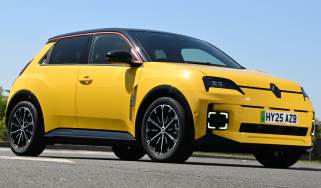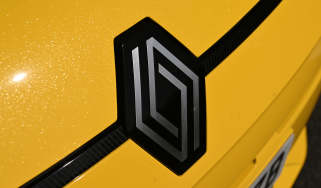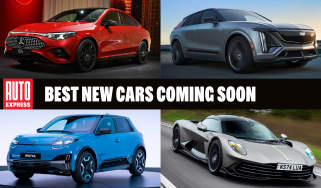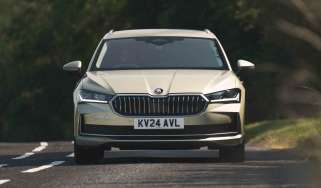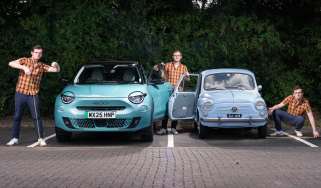Renault Embleme concept could become the next-gen Espace
Renault is exploring ways to put the Embleme concept into production
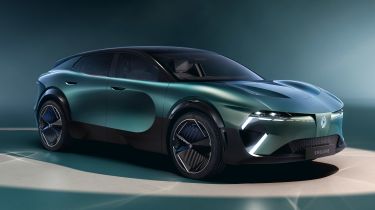
Renault is working on an exciting new flagship crossover with lots of space and a family-friendly focus – think of it as the Reanult Espace of tomorrow.
The company showed the long and sleek Embleme concept last year, and Renault’s design and engineering team is exploring ways to put a similar concept into production. It’s likely to be all-electric and will probably be the next-generation Espace, landing before the end of this decade.
“What do we think will be a future D-segment [executive class] electric car?” Renault brand boss Fabrice Cambolive asked Auto Express at the Financial Times’ Future of the Car Summit. “This is something which we are looking [at]. But [for now] it's part of our secret recipe.”
Cambolive extrapolated that Renault was eager to use the additional cabin and trunk space unlocked by electric car platforms, which don’t need to accommodate an engine, and the aerodynamic benefits of a long car to boost range: together that concept sounds a lot like the Embleme.
“The Embleme is the purest expression of where we want to push the modern part [of Renault design],” Renault Group’s design director Laurens van den Acker told Auto Express. “Don't underestimate Embleme: it's a beautiful object. It's one thing to seduce [people] with a form that you know – it's another thing to seduce you with something that's completely new.”
Think of it as Renault’s alternative to the Citroen C5 X, which is nearly identical in size and also a five-door crossover. Renault describes the Embleme’s bodystyle as a shooting brake, the classical term for a slender, often two-door estate car.
“For me, it's the proportion of the future,” explains the Dutch design leader. “It's a little bit lower than an SUV but it's a little bit taller than a saloon for the simple reason that we need to put the batteries in the floor.”
Pure electric or hybrid?
The Embleme show car runs a range-extender hybrid powertrain, with the 40kWh battery pack charged from a plug or by a hydrogen fuel cell mounted in the nose. The battery feeds a 160kW (215bhp) motor mounted on the rear axle.
No current production Renault is rear-wheel drive, but future iterations of the Embleme’s AmpR Medium platform should be sufficiently flexible to site an electric motor up front, in the rear or even combine motors for high-performance four-wheel drive.
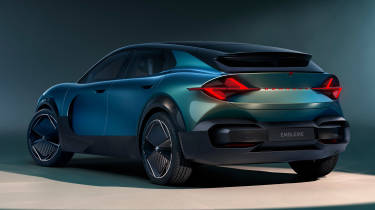
The big question is whether the production Embleme will be electric or hybrid? While arch rival Peugeot uses ‘multi-energy’ platforms from its parent group Stellantis, meaning both EV and electrified combustion versions can be built on one architecture and go down the same assembly line, Renault’s current strategy is to have separate platforms.
Van den Acker says that if you mix the two powertrain types, the additional frontal area needed to safely package combustion engines makes a car longer but compromises interior space that could be allocated to an EV. “So you either have a long [hybrid] car that isn’t spacious enough or a short [electric] car that is too heavy,” he argues.
The Embleme has a long, 2.9-metre wheelbase (not far off the new BMW 5 Series’), relatively short overhangs and a stubby nose – the classic proportions of an EV. These proportions could be protected or even enhanced by using the next-gen AmpR Medium platform. And the smart money is on pure EV, as per brand boss Cambolive’s thinking.
The cabin should live up to the spacious, flexible designs of iconic MPVs the Scenic and Espace, hints Cambolive. It doesn’t need to reach 5m-long to spaciously package five or even seven seats: the forthcoming electric Twingo is a city car harbouring the cockpit space of a supermini.
“You have the best world of both segments,” muses Cambolive. “And in the UK, it’s a segment which is not existing or very low [for non-premium car brands], so it will be very interesting to come with this proposal. You mention our experience in the past with Scenic, or in the past with the 1992 Twingo and its sliding bench – it's something we we could reinterpret with our next generation.”
The Scenic E-Tech, which is 33cm shorter than the Embleme, can stow 87kWh of batteries between its wheels. Renault’s future flagship could conceivably package more cells, though the thinking behind hydrogen range extenders is to halve the size of the battery and reduce the consumption of raw materials. Thanks to the fuel cell creating electricity on board, the Embleme can drive 621 miles with just a couple of five-minute stops to gas up the tank – assuming you can find a hydrogen filling station.

While Toyota may have productionised fuel cells with the Mirai, don’t expect Renault to follow suit. The powertrain choice is between petrol/electric hybrids – options already offered in the slightly shorter Rafale coupe-SUV – or pure battery electric to create a zero-emissions flagship. Given that the production Embleme isn’t expected before 2028, Renault won’t have to finalise powertrains for a while and can watch if the EV adoption curve intensifies – or if Europe’s phase-out date for petrol hybrids recedes.
Regardless, Renault will soon have a second battery chemistry in production. Its current batteries are NCM (nickel cobalt manganese) but it will be adding European-sourced lithium iron phosphate (LFP) cells in 2026. As popularised by Chinese car maker BYD, LFP batteries don’t need any cobalt but are typically less energy dense than NCM batteries. Renault plans to overcome this with an efficient ‘cell-to-pack’ design that crams in more cells. Switching to LFP should reduce battery cost by 20 per cent, helping boost margins and ideally bring down EV prices.
The batteries will be recyclable, in keeping with the Embleme’s philosophy – half of the concept’s materials are recycled and the carbon footprint of its components reduced by 70 per cent. This is an extreme example of Renault’s corporate commitment to increase the recycled content of production vehicles to a third of its weight by 2030.
Range and efficiency
It’s too early to talk about electric range but today’s 87kWh Scenic can travel more than 350 miles on a single charge. The Embleme sits fractionally lower and is peppered with aerodynamic touches: hidden windscreen wipers and door handles, cameras replacing wing mirrors, a front cooling vent that opens only when needed and a flat underbody with an active diffuser to minimise drag. If the latter sounds like something out of Formula 1, it is – the BWT Alpine F1 team assisted with digital wind tunnel testing.
All those drag-reducing measures are clothed in curvaceous, clean body panels that epitomise the future of Renault design. “[Embleme is from] the futuristic part of Renault, so cars with extremely desirable proportions and getting back some Latin sensuality,” says the group design director. The long wheelbase makes for a spacious occupant cell and the car is “relatively practical”, he adds.
“In the next few months, it will be very clear what the next generation [of cars] should be, for 2028-29. We're doing scenarios every day, trying to find a way,” concludes the design boss. Sounds like an innovative, electrified heir to the original Espace looms ever closer.
Find a car with the experts

